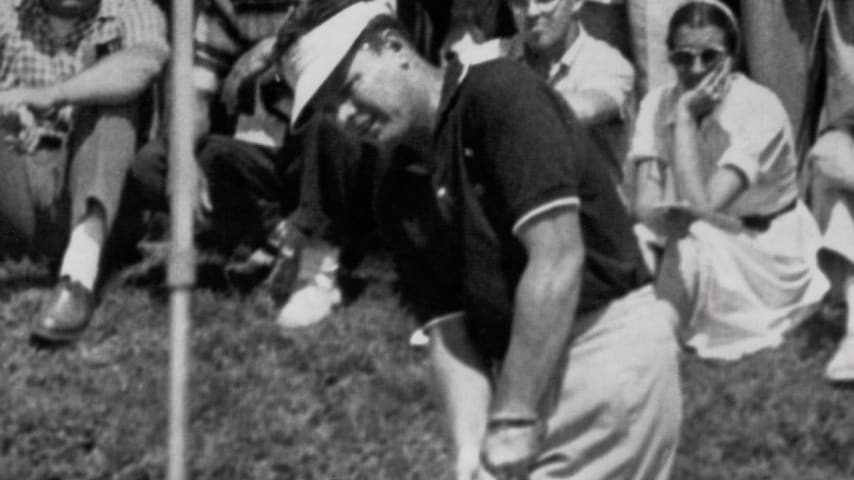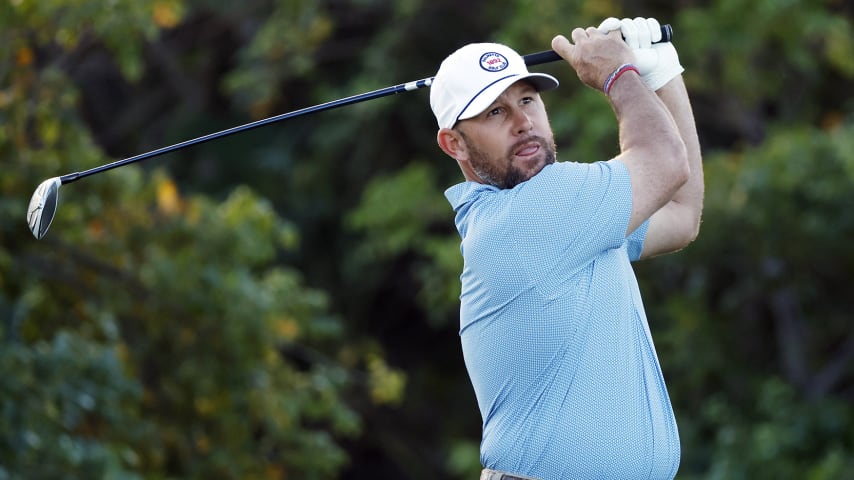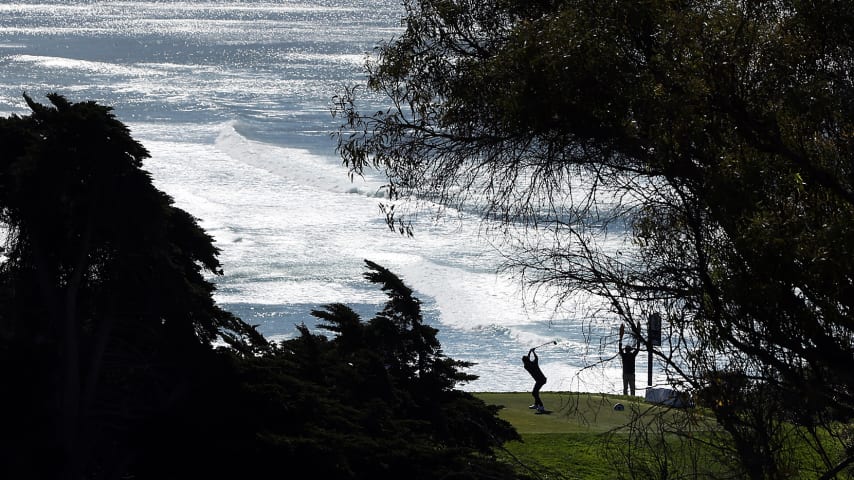Happy 100th birthday to Jack Burke, Jr.
10 Min Read

Prolific PGA TOUR winner, World Golf Hall of Famer was born to play the game
Written by Laury Livsey
Prolific PGA TOUR winner, World Golf Hall of Famer was born to play the game
In summing up Jack Burke, Jr.’s PGA TOUR career, do you focus on his four-win 1950 season, his five-victory 1952 campaign – with four of the wins coming in succession – or should the discussion center around his back-to-back major championships in 1956?
Or how about all three years? After all, those seasons, which brought him a whole lot of wins, give a good overview of Burke’s career. The Texas legend turns 100 today, and that makes him the oldest living PGA TOUR winner and the oldest living World Golf Hall of Fame member. By far.
Yes, hit triple-digits and you will carry with you a lot of distinctions.
As the son of professional golfer Jack Burke, Sr., the younger Burke was seemingly born to play the game for a living. It just took him a while to get going. After accepting the head pro job at Galveston Country Club as an 18-year-old (what were you doing at that age?), Burke joined the Navy and served his country for four years. He then slowly started his career, playing the sport for a living but not touring on a week-to-week basis until he was 27.
Once he began as a TOUR regular, though, it didn’t take the Fort Worth, Texas, native long to win. In 1950, after sharing the Bing Crosby Pro-Am title with Sam Snead, Smiley Quick and Dave Douglas, each earning a victory, he won the outright title at the Rio Grande Valley Open in Harlingen, Texas, doing so in style by hitting driver-driver and then tapping in from two feet for an eagle that gave him a two-shot win over Skip Alexander. Burke also won the St. Petersburg Open in Florida and finally the Sioux City Open.
While his four 1950 wins were impressive, Burke didn’t win Player of the Year, as Snead won eight times, Lloyd Mangrum five and Cary Middlecoff matched Burke’s four-victory total.
Two years later, Burke took home four more tournament titles but did something none of those other three players could match. Burke won, count ‘em, four tournaments in succession over a 24-day period. Also, he didn’t just win four tournaments in a row, he basically blitzed the field except for his playoff win over Bill Nary and Tommy Bolt in Baton Rouge. His other victory margins were six, six and eight strokes, respectively.
“I felt if I played it too safe, I might get in trouble,” he later said.
Yet during all this winning, Burke had been unable to break through in a major championship. Close calls? Sure. There was his second-place finish at the 1952 Masters; oh, what might have been but for a third-round 78. An opening-round 78 at Augusta a year later prevented him from seriously contending, leaving him alone in eighth. Then, in 1954, same course, same scenario, a 5-over 77 in the second round left him tied for sixth, three shots out of the Snead-Ben Hogan playoff that Snead won.
Burke also had final-round 77 at the 1955 U.S. Open (tied for 10th) and another flirtation with a win at the 1955 PGA Championship. After rolling past Douglas, Guy Paulsen and Marty Furgol in match play, Burke battled Middlecoff all day at Meadowbrook Country Club in Michigan before going into overtime and finally losing on the 40th hole of their quarterfinals match.
Burke didn’t win in 1955, and when the 1956 Masters rolled around, the annual spring invitational in Augusta, Georgia, had a different feel. TV cameras descended on the venerable golf club for the first time, CBS Sports televising the tournament live. Fans in their living rooms could watch 30 minutes of live golf during the second round and listen to and watch Chris Schenkel and Bud Palmer announce the action on the last four holes of the tournament both Saturday and Sunday.
For CBS, the third round didn’t bring much drama. The final round was a different story.
With 18 holes to play, it looked like an amateur, Ken Venturi, would win the tournament for the first time. Another amateur, Bobby Jones, had started and nurtured the Masters into what it had become, and now Venturi had forged a four-shot, 54-hole advantage over Middlecoff, was seven ahead of Doug Ford and eight clear of Mangrum and Burke. Middlecoff, the media agreed, was seemingly the only guy with a reasonable chance of catching the 24-year-old Venturi. Burke had other ideas.
With nine holes to play Sunday, Burke had shaved the deficit to five strokes, and by the time he stepped to the 16th tee, in view of TV cameras and Venturi playing two groups behind, Burke trailed the amateur by only two strokes. Venturi would end the tournament in tears as he shot a back-nine 42 to fall to Burke by a shot. Burke had his green jacket, and his first major.
It only took him 107 days to get major title No. 2. Burke defeated Leon Pounders, Bill Collins, Fred Haas, Chandler Harper, Fred Hawkins and Ed Furgol to get to the championship match at the PGA at Blue Hill Golf and Country Club in Canton, Massachusetts. From there, he took down Ted Kroll, 3 and 2, in the championship, to capture the Wanamaker Trophy.
Two consecutive major championships put Burke in select company. At that time, only Sam Snead had won both the Masters and the PGA Championship in the same season. With the PGA doing away with the match-play format for its championship following the 1957 season, but not before Burke assembled a gaudy career record of 15-6, and a 71% winning percentage.
Eventually, Burke curtailed his playing career and settled down at the course he and Jimmy Demaret built in Houston, Champions Club. There, Burke mentored numerous players through the years. Burke’s final full PGA TOUR season came in 1963. It was also the year of his final TOUR title at the Lucky International in San Francisco. Burke shot a final-round 67 at Harding Park Golf Course to defeat Don January by three strokes. Two days later, Burke marked his 40th birthday in Palm Springs.
Amazingly, he’s had 60 such celebrations since.
10 Jack Burke, Jr. facts
1. Jack Burke, Jr. was a second-generation American and a first-generation Texan. His paternal grandfather, John Joseph Burke, was born in Ireland in 1855, as was his grandmother and John’s wife, the former Kate Pendegrast. The Ireland Burkes immigrated to the U.S. and had six children: Eugene, Edmund, Winifred, Thomas, Mary and John. Born in Philadelphia in 1895, John was nicknamed Jack and became a professional golfer. Twenty-eight years later, his son, John Joseph Burke, Jr.—actually John Joseph Burke III – came into the world on January 29 in Fort Worth, Texas. He, too, carried the nickname Jack, and golf was also his chosen profession. The younger Burke eventually made it all the way to the World Golf Hall of Fame.
2. Burke’s first two PGA TOUR starts came as an amateur, at the 1940 Western Open (tied for 37th) and the 1941 Texas Open (withdrew after one round). At what would have been the likely start of his PGA TOUR career, after taking his first professional job—as the head pro at Galveston Country Club—Burke took a break to serve his country, beginning in 1942. He moved to California, assigned to the Marine Corps Air Station Miramar in San Diego, where he taught self-defense classes and martial arts, primarily judo. Burke didn’t return to the PGA TOUR until 1946 and didn’t play a full season—24 tournaments—until 1950, when he was 27. Burke’s professional path at the time, though, was not unusual, as Sam Snead, Ben Hogan and Lloyd Mangrum, among many other athletes both inside and outside golf, served in various arms of the military during the U.S. involvement in World War II.
3. His scores of 67-65-64-64 at the 1952 Texas Open set the PGA TOUR’s 72-hole scoring record—since broken—on a course at par-71 or higher. Burke defeated Doug Ford by six strokes, the first of four wins in succession, posting his 64-64 finish all on the same day—the Brackenridge Golf Course-hosted tournament used a Sunday, 36-hole finale.
4. Prior to his 1952 four-tournament winning streak, Burke discarded a blade putter he used up until that season’s Los Angeles Open. After three-putting the 72nd hole at Riviera Country Club, a miscue that dropped him into a playoff with Tommy Bolt and E.J. “Dutch” Harrison, an overtime session he would ultimately lose to Bolt, Burke switched to a mallet-head putter. He proceeded to make the cut in his next five tournaments, with his only top-10 a tie for seventh at the Phoenix Open. Yet he stayed with the putter, and that was a smart move. Burke then rattled off wins at the Texas Open, Houston Open, Baton Rouge Open and St. Petersburg Open, finishing a cumulative 60 under in those 16 rounds.
5. After winning in St. Petersburg in 1952, instead of trying to win a fifth tournament in five weeks, Burke traveled to Pinehurst, North Carolina. There, he was part of a golf exhibition for the American Red Cross. But instead of staying in the Tarheel State, he elected to withdraw from the Greater Greensboro Open and return home to Houston. In his next official start, two weeks later, he tied for 28th at the Jacksonville Open.
6. Burke, a lifelong Texan, for many years represented and played at a course far from the Lone Star State: the Concord Resort Hotel in Kiamesha Lake, New York, in the Catskill Mountains. Concord was the largest resort in the region and capitalized on Burke as a celebrity endorser to attract visitors.
7. At age 81, Burke was invited by U.S. Ryder Cup Captain Hal Sutton to serve alongside Steve Jones as an assistant captain. As a player between 1951 and 1959, Burke played in five straight Ryder Cups, serving as a player-captain in 1957. He was also a non-playing captain in 1973.
8. His creation of Champions Golf Club in Houston, with fellow pro Jimmy Demaret, is well-known, the venerable course hosting significant tournaments through the years, including a Ryder Cup (1967) and the 1969 U.S. Open. But in 1957, the same year Champions opened, Demaret, as president, and Burke, as vice president, also opened the Dick Wilson-designed De Soto Lakes Golf and Country Club in Sarasota, Florida. Now known as Palm Aire Country Club, De Soto Lakes was the site of the PGA TOUR’s 1960 De Soto Open Invitational won by Sam Snead. Burke tied for 14th that week.
9. At the 1950 Bing Crosby National Pro-Am—now AT&T Pebble Beach Pro-Am—the scheduled 54-hole tournament, using a Friday-to-Sunday format, ended with Burke, Dave Douglas, Smiley Quick and Sam Snead deadlocked, at 2-under 214. With not enough daylight to conduct a sudden-death playoff and players scheduled to travel down the California coast, to Long Beach, the next day for the Long Beach Open, tournament officials declared four champions, each player receiving an official-victory designation. It remains the only time in PGA TOUR history that a tournament has declared four champions.
10. By the time PGA TOUR Champions began, in 1980, Burke was 57 years old and well past his competitive best. While he played in numerous unofficial Liberty Mutual Legends of Golf tournaments, primarily teaming with Paul Harney, his only official PGA TOUR Champions start came at the 1984 Vintage Invitational in Indian Wells, California, where he tied for 21st, 13 strokes behind winner Don January.





